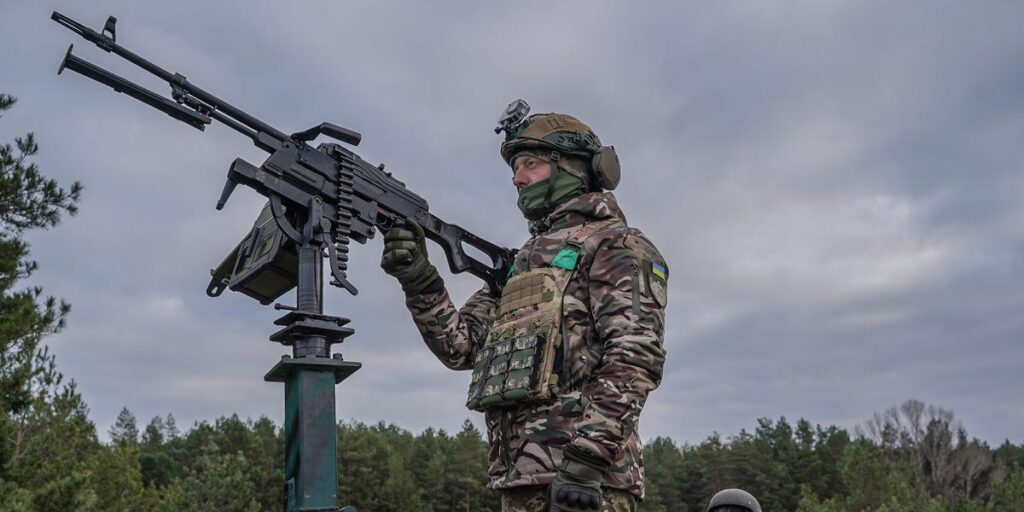Russia’s drone attacks are becoming increasingly complex, with enemy threats becoming harder to kill, the team leader for a Ukrainian mobile air defense unit told Business Insider. He said higher-reaching weapons are needed to beat them.
Oleksiy, the deputy commander of an air defense unit with Ukraine’s Territorial Defense Forces, said Russia’s drone tactics have changed over the last few months; it is now operating drones at higher altitudes and using modified ones that can fly faster. This presents a challenge for air defenders, particularly those armed only with pickup truck-mounted machine guns.
At the heart of Russia’s drone attacks is the Shahed-136, an Iranian-designed weapon that Moscow now also produces at home. Historically, these one-way attack drones could fly at speeds of over 115 mph with a nearly 90-pound explosive warhead.
Though the Shaheds are slower and less lethal than cruise or ballistic missiles, they are significantly cheaper, allowing Russia to launch them in large-scale attacks. Last weekend, for instance, Moscow sent 273 of them into Ukraine, marking one of its largest drone attacks since Russia launched its full-scale invasion over three years ago.
Oleksiy, whose unit is tasked with protecting civilians and critical infrastructure on the outskirts of Kyiv, said that Russia still operates the conventional Shaheds. But Moscow is now using a modified version with an engine that enables it to travel at speeds of over 180 mph. It has also increased the explosive payloads of the old and new drones to more than double the original.
Russia is using decoy drones, too. These don’t have warheads but are designed to exhaust Ukraine’s air defenses because they look convincing, appearing just as deadly as the real thing. And while they are unarmed, these drones can perform long-distance reconnaissance missions.
Russia used to launch its Shaheds at low altitudes to avoid radar detection. However, it is now flying the drones higher, at over 8,000 feet — beyond the reach of the machine guns that the mobile units are using. BI previously observed Oleksiy’s unit fielding a .50 caliber M2 Browning mounted in the bed of a truck.
Oleksiy said that this newer tactic makes the Shaheds inaccessible to mobile fire groups like his — all they can do is observe them and report back. These loitering munitions can then gather in a specific area and simultaneously strike targets. He said that while the Ukrainians can still shoot them down, the kill figures “have begun to decrease.”
Russia’s defense ministry and its embassy in the US did not immediately respond to requests for comment on the change in tactics described to BI.
In a February intelligence update, Britain’s defense ministry wrote that Russia could likely launch at least 2,000 drones each month for the entire year. On Saturday night alone, it attacked Ukraine with almost 300 drones, Kyiv said.
“To overcome this altitude barrier and stably engage drones with firepower, mobile groups need to use additional weapons,” like shoulder-launched surface-to-air missiles, or MANPADS, Oleksiy said.
MANPADS stands for Man-Portable Air Defense Systems. In Ukraine, common examples are the American-made FIM-92 Stinger or Soviet-era 9K38 Igla. These are typically used to shoot down threats like low-flying aircraft, such as helicopters, and even cruise missiles.
“Right now, there is a shortage of inexpensive, hand-held MANPADS systems to shoot down drones,” Oleksiy explained. “The military is ready to undergo a rapid course in MANPADS operation and use this means of destruction when it is impossible to do so with machine guns.”
He said that a combined-arms approach to destroying drones, like using portable missile launchers in tandem with machine guns, would strengthen Ukraine’s ability to defend itself.
“If our unit were additionally equipped with a manual MANPADS,” he said, “the effectiveness of destroying air targets would increase by twofold.”
Read the full article here


